
The other day I saw a chart from Brown University that maps the 70+ countries where the U.S. has “War on Terror” military operations going on (there are likely more, where the secrecy level is higher). And it set me to remembering.
That’s an awesome number: seventy-plus countries we’re at war in. Even on a small scale, which it appears they are mostly — it adds up.
“Adds Up” in lots of ways. Many of these “operations” use drones, and pile up unnamed, uncounted & unknown (to us) civilian casualties.

Acknowledged government figures for civilian deaths are contradicted by credible independent estimates that are much higher. And of course there’s the money, about a trillion a year, and going up.
All this is happening now, and what set me to remembering was the recent deep plunge in temperature here in North Carolina and along the East coast. It brought back another chilly January, in 2007, when there was a big antiwar rally in Washington.
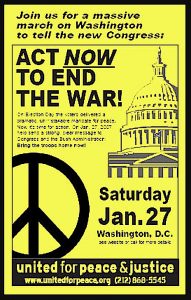 As many as several hundred thousand showed up for it, well-bundled up. That included me and a bunch of my friends. We even filled a bus for it in Fayetteville, NC, where I was working at Quaker House, a peace project near Fort Bragg.
As many as several hundred thousand showed up for it, well-bundled up. That included me and a bunch of my friends. We even filled a bus for it in Fayetteville, NC, where I was working at Quaker House, a peace project near Fort Bragg.
The march had the usual psychological effect on me: a boost in enthusiasm and hope. It lifted my spirit to see the national mall crowded and dotted with signs for an end to the wars.

But this high soon faded. As it turned out, there was good reason for that: the wars went on, and spread, and got more secret.
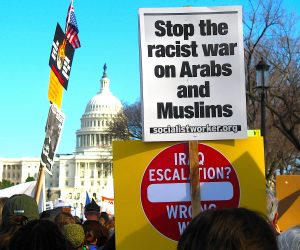 Along with all that there was another depressing fact: 2007 was when what we used to call the “peace movement” disappeared. The January 2007 rally wasn’t the beginning of a big new push, but instead, its last hurrah. Then the mass peace movement was over, as an active public force, and has been gone for now eleven years and counting.
Along with all that there was another depressing fact: 2007 was when what we used to call the “peace movement” disappeared. The January 2007 rally wasn’t the beginning of a big new push, but instead, its last hurrah. Then the mass peace movement was over, as an active public force, and has been gone for now eleven years and counting.
Not that there’s no one working to end the wars, and war: you could make an impressive list of small projects here and there.

But still. Was there a “peace candidate” in the last big election? If so, I didn’t notice. Was there a movement demanding a peace candidate? I must have missed that one too.
True, there have been big rallies in recent times. The women’s march; awesome indeed. And even the March for Science; amazing.
So, what happened to peace? Where did its “movement” go? What could bring it back? Would we even want it back now? What’s the alternative?
It may sound strange to young ears today, but the first half of the 2000s were marked by numerous big peace rallies, the largest rallies ever. They thundered around the world before the Iraq invasion was loosed in March 2003. Then huge followup rallies happened again, more than once.
The 2007 rally was organized by “United for Peace & Justice”, or UFPJ, a lefty umbrella coalition. UFPJ had organized some of the biggest U.S. rallies of those years. January 2007 was UFPJ’s last stand too.
 I was on their planning committee then. We met shortly after the Democrats had just won big in the November 2006 off-year election, giving them control of both houses of Congress starting in early 2007.
I was on their planning committee then. We met shortly after the Democrats had just won big in the November 2006 off-year election, giving them control of both houses of Congress starting in early 2007.
We thought this was the chance to pressure them to rein in (or better, stop) the wars in Iraq, Afghanistan and (secretly) elsewhere. Then maybe Congress could call to account some of the officials involved. I was thinking of those who ordered the Iraq invasion under false pretenses, and those connected to war crimes, vast war profiteering & corruption, and the undermining of civil liberties here at home.

That was for starters; I had quite a list, and wasn’t alone in that.
So I was all for the march. I urged that we hold the rally shortly after the new year, to lay out our demands before Congress got seriously down to work.
“That way,” I said, “the Democrats won’t have sold us out yet, so people will still be hopeful and energized.”
Was I cynical? Yep. But not wrong:
I had guessed right about the timing, in two ways: one, people were still hopeful in January, which boosted rally turnout.
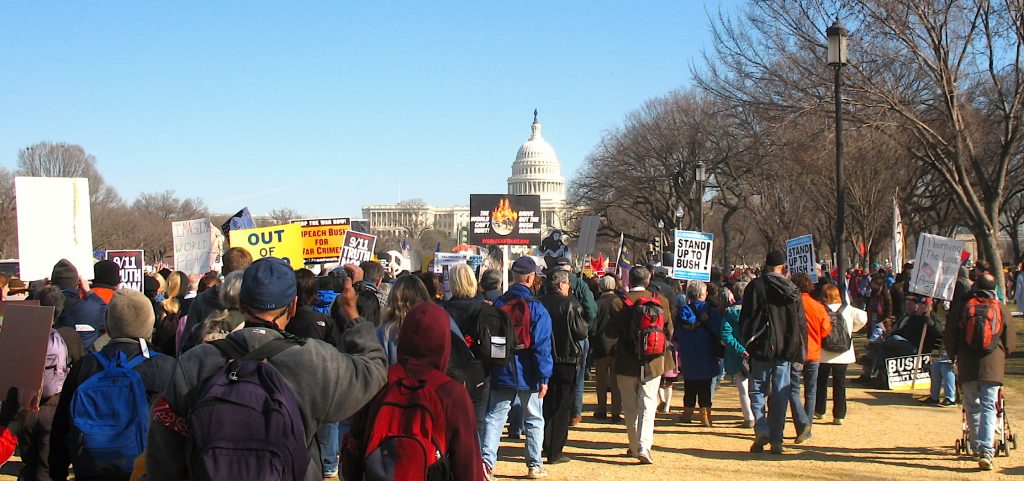 And two, sure enough, once Congress got going, the Democrats swiftly sold out all the main things we had rallied for: accountability (“Impeachment is off the table,” said House Speaker Nancy Pelosi);
And two, sure enough, once Congress got going, the Democrats swiftly sold out all the main things we had rallied for: accountability (“Impeachment is off the table,” said House Speaker Nancy Pelosi);

there were no serious investigations of war crimes or corruption; impunity for torturers continued, and they voted for all the bloated war spending bills (“gotta support the troops”), etc.
Peace folks’ morale plummeted as quickly. We felt this in spades in mid-March, when it came time for our fourth annual peace rally in Fayetteville, to mark the launching of the Iraq invasion.

We did, I think it can fairly be said, a great job of planning this Fayetteville rally: we assembled a bunch of eloquently angry antiwar Iraq veterans.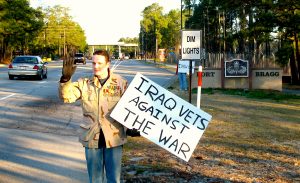
We brought in well-known activist singer Holly Near; there were numerous excellent speakers; great signs and banners.
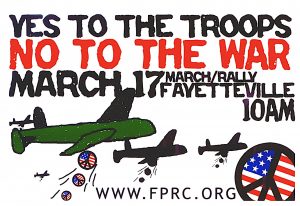
The only thing the Fayetteville rally lacked was people; the turnout was pathetic. It was the last of our four such annual rallies; we knew a flop when we had to face up to one.

At Quaker House, we still kept busy. Being close to Fort Bragg, a major war center, we had plenty to work on locally.
But we were largely on our own there; and didn’t fit into a larger “peace movement” after that, because — well, there wasn’t any.
What happened to it? I have some suspicions.
 A big one was that our “theory” of the mass peace movement was discredited, especially among us, the rank and file. That theory was a variant on what most of us middle class movement folk had picked up in and around school: the U.S. is a democracy. If the government goes wrong, the people can rise up and put peaceful pressure on it and push it into changing course. Public pressure, plus elections, can fix what’s wrong.
A big one was that our “theory” of the mass peace movement was discredited, especially among us, the rank and file. That theory was a variant on what most of us middle class movement folk had picked up in and around school: the U.S. is a democracy. If the government goes wrong, the people can rise up and put peaceful pressure on it and push it into changing course. Public pressure, plus elections, can fix what’s wrong.
That theory had seemed to work in the 1960s, the heyday of the civil rights movement: marches, protests, eloquence and nonviolent suffering yielded the Civil Rights and Voting Rights acts, and these made an actual difference in many peoples’ lives. They didn’t solve all our racial issues, but supported a belief in “progress.”
 But the 2000s version of that theory was a bust: we held even bigger marches and rallies, and heard a decent sampling of eloquence — and all were simply ignored by a U. S. regime bent on big war, come hell or high water. They weren’t mere militarists: their goals were messianic.
But the 2000s version of that theory was a bust: we held even bigger marches and rallies, and heard a decent sampling of eloquence — and all were simply ignored by a U. S. regime bent on big war, come hell or high water. They weren’t mere militarists: their goals were messianic.
Some of us kept hope alive in the first years of the “Iraqistan” debacle by telling ourselves — “Yes, but — those are war-mongering Republicans. If we can replace them with Democrats, people we like, we can turn this around.”
It didn’t happen, of course. In 2004, the war-mongers won (or stole, take your pick) the presidential race. Progressive folk were left in shock, and many sought therapy in order to cope. #Metoo.
Then the 2007 Congress turned out to be, as far as the wars were concerned, pretty much a fraud. Faced with the wars the Republican regime enjoyed so much, the promises of Democratic backbone turned into a plate of tepid spaghetti.
Shortly after the 2007 disappointments, most of our attention was diverted by the spectacle of the 2008 election, which seemed to offer hope in the meteoric rise of an articulate, seemingly progressive African-American candidate. Who could resist that?
The Obama years did bring some signs of progress. He ratcheted down the Iraq war; “Don’t Ask, Don’t tell” was dumped, transgender folks were allowed to stay in the military openly. What was there to protest en masse? We began hearing more about drones, but the reports were scattered and easy to ignore. No group, no issue seemed to gain purchase, except the shining moment of Occupy Wall Street.
 Yet that, like Alice’s Cheshire Cat, soon vanished, leaving only a 99% shaped grin.
Yet that, like Alice’s Cheshire Cat, soon vanished, leaving only a 99% shaped grin.
As for the overall worldwide picture, it soon became clear, to those who could bear to look, that war-making hadn’t really decreased. Instead, it had been growing, but in a widely dispersed way, with most operations kept on a relatively small scale, and almost all wrapped in thick curtains of secrecy.
At the same time, Obama repeatedly upheld the impunity of torturers and other likely war criminals. He prosecuted leakers much more aggressively than had his disgraced predecessor. His war record, while still being assayed, is painfully, bewilderingly mixed, with the balance tilting right into the sprawl of 70-plus interlinked mini-wars we now see on the Brown University chart.
Furthermore, this approach was reinforced by technical difficulties for journalists. How do you report on drone wars where missiles land thousands of miles away from where the controllers press the electronic triggers? How do reporters coherently track combat in 70-plus countries? (For that matter, how much real control is wielded by the Pentagon, and the burgeoning spy agencies?)
Underlying it all, for many former movement folk, there was deepening war fatigue and discouragement. How do you mobilize hundreds of thousands to protest wars in places most participants can’t even name? And how hard is it to face the reality that the war machine largely runs itself, and that even people you want to like in the White House can hardly slow its lethal momentum?
And how do we face the fact that our lingering 1960s view of movement-reformed democracy doesn’t seem to work anymore. Not up against this war machine.
Confronted with all these questions, the broad public reaction is to turn away. “Thank you for your service — and now I have to get to the mall, or class, or work, or soccer practice.” If the appeal is phrased just right, I might write a check. And there’s always the next election to obsess about.
If I had a “To-Do” list that would cut through this thick fog of ennui and denial, I’d be happy to share it. And I have written about work that seems meaningful in this setting.

But I don’t know how the mass peace movement can be revived. I’m not even sure anymore if that would be a good idea; though admittedly, I miss it.
So here I’m left to grapple with the realization that as 2018 begins, the American generation that’s on the cusp of puberty is living in a society with 70-plus ongoing wars, and a “peace movement” that’s no more real to them than unicorns or Hogwarts, and maybe less so than Harry Potter’s alma mater.
Maybe Dumbledore has a suggestion?


At the same time a small band from Reading Friends Meeting met in the Penn Street Bridge every week and demonstrated against Iran and Afghanistan involvement. I questioned why PYM wasn’t leading a Peace Movement. What about relief from AFSC?
I was told we are too small and powerless. AFSC doesn’t do that anymore. It was suggested that maybe I was a zealot.
Maybe we need to start at home. If there is a war with North Korea, how will Friends respond?
Hi Chuck,
Thanks for the map!
I believe much of the peace movement has recognized that unless Americans PRACTICE the values we believe in, it is hard to expect any changes in how we treat our “neighbors”
Perhaps the peace movement is dead it that it still expects people to still do things the “old fashioned” way? Standing on a corner when everyone walking by is looking at their cellphones doesn’t really register with anyone, does it?
Robert Bly, (poet) thinks that “America is a country that has colonized its own people.” Perhaps people don’t realize they are on a treadmill that can change speed as they do? We now have hundreds of distractions that compete for even fewer “free hours” of our time.
When the universal draft ended, millions of middle and upper class families stopped caring about wars “over there”, as their children would not be “over there”. Now we have a paid only military, who is more and more insulated from “civilians” .. even retired vets, it seems.
Remember when President Richard Nixon (The birthright Quaker from Southern CA) resurrected the “alt right” based in the Southern USA and then proceeded to fan hatred of the “other” to all sections of the country. He won with that drumbeat and we now see hear it in mainstream Republican politics. And sometimes in Democratic politics as well.
Here in GA, white working class people vote against their own economic interests so as to maintain a wall between “those people” and “the real Americans”. So racial justice is now part of the “Peace Movement’. FINALLY!
We also have seen the liberation of Gay People and Transgender people. The “peace movement” wins another victory by eliminating another scapegoat.
Now we face deportation of millions of people who are Spanish speaking “neighbors” with a GIANT, BEAUTIFUL WALL” keeping anyone South of the USA border from entering.
Perhaps we don’t do what the “old timers” did because we now see that Pogo was right all along: “We have met the enemy and it is us!”
The “opioid crisis” (poisoned, unregulated drugs) is killing more Americans than the Vietnam war! (including my youngest son!). Where is the “peace movement” helping end the “War on Illegal Drug Users”? I don’t see them marching in the streets to help “Save the Children” from stupid drug laws. Laws that are now to be used to resume locking up people for using small amounts of Pot! Do you see any Quakers marching to end this war on our own youth?
How can you sell “Peace” overseas when we have police being militarized here in our back yard? Our prisons have over 2,000,000 people locked up in prisons 1/2 of whom we know work for next to nothing , day after day, year after year.
For 20 years a not for profit I co-founded here in GA has been working to help people stay out of prions. Where are the peace people? Some are protesting capital punishment and especially how it effects black men, but not with much success as the States have most of those on death row.
Unions are in decline, wages are dropping (if one adjusts for inflation) as more and more jobs are automated. They were moved to the Right when they stopped worrying about their jobs and began to worry about “those people” moving into their neighborhoods. So unions are less relevant today and cannot support “peace”, even in the workplace.
Perhaps what happens in North Korea is less important than what is happening in our own backyard? Surely China and Russia, who border on N. Korea, have an even greater interest in how that country behaves. They could actually do something that would impact that country. Yet, as long as the USA obsesses about President Kim, then it works to their political advantage to leave him be for us to mired down.
Again WE, THE USA, ARE THE PROBLEM. Same with Iran, Iraq, Israel, Palestine, Pakistan, Afghanistan, Central and South America.
Happily, the women on America are now leading us to a more peaceful world. The “War on Women” is finally front and center.
Perhaps the “Old Timer Peace Activists” need to let go “the good old days” and telling us how awesome they were and help the young people who also want PEACE but not “OVER THERE”. They want it RIGHT HERE!
They want to be able to drive down a highway without being stopped and killed by their own police.
They want to not be blamed for when they are raped and are molested.
They want to be listened to when they say they can’t get equal pay for equal work.
They want to stop worrying about health care, that somehow the rest of the industrialized world has managed to provide their citizens.
They want to be able to travel without having to cross walls we built.
They want the “old timers” to shut up and listen to them.
Whew, that really opened up some wounds in me that have not been addressed. Thanks for this opportunity.
typo on paragraph 6, last sentence should be: “So racial justice is NOW part of the “Peace Movement’.
I agree with much of Free’s concerns. And I remember how wonderful it felt to march with hundreds of thousands in the Peace Movement.
I know there are thousands, probably tens of thousands–or even more–small local and perhaps regional groups working on all the issues Free mentions, and also on environmental issues throughout the country.
Use of social media has helped in that people can know about the work of others and in the case of the “War on women” have been instrumental in developing a large (and I fervently hope) movement that looks like may bring about significant changes (but only if women who become empowered keep their oppressed sisters and brothers in mind).
In my generation, the Peace Movement grew strong in its resistance to a specific war, Viet Nam. Some of us learned to oppose militarism, imperialism, and injustice on a wider scale through participating in that movement, and others went back to school, jobs, family responsibilities, and even, sigh, the addictive consumerism of the US economy.
As opportunities for our children and grandchildren become more limited even in these areas, I believe we and the young ‘uns will find ways to resist and develop alternatives, Our survival is at stake.